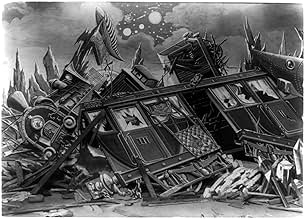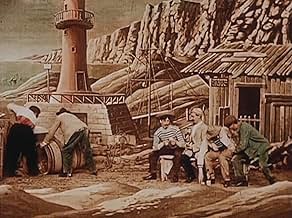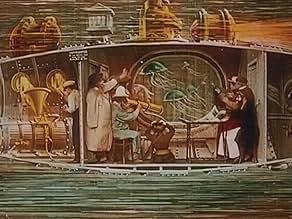Il viaggio attraverso l'impossibile
Titolo originale: Le voyage à travers l'impossible
VALUTAZIONE IMDb
7,4/10
4285
LA TUA VALUTAZIONE
Aggiungi una trama nella tua linguaUsing every known means of transportation, several savants from the Geographic Society undertake a journey through the Alps to the Sun which finishes under the sea.Using every known means of transportation, several savants from the Geographic Society undertake a journey through the Alps to the Sun which finishes under the sea.Using every known means of transportation, several savants from the Geographic Society undertake a journey through the Alps to the Sun which finishes under the sea.
- Regia
- Sceneggiatura
- Star
Fernande Albany
- Madame Latrouille
- (non citato nei titoli originali)
Jehanne d'Alcy
- Villager at seaport
- (non citato nei titoli originali)
May de Lavergne
- Nurse in Swiss hospital
- (non citato nei titoli originali)
Recensioni in evidenza
This is a crazy, delightful mess. Explorers make an effort to go to lands never seen and report back. They try to use every conceivable vehicle to go over mountains, under seas, through outer space, actually visiting the sun (I wonder if they went at night so they wouldn't get burned). There are laughs galore because the stuffed shirt explorers were in no way equipped to do any kind of huge investigation. No matter what horrible things happen to them, getting frozen, blown up, crashing from a hundred miles away, going through the sun, and on and on, they always make their way out. One of the stars of this film is the painted scenery. Melies really liked the jagged edges of the mountains and wacky surreal realms of the outer world.
really a great hand colored early science fiction movie with full of early special effects,greatest moment in the film that they reach the sun and go into the suns mouth with a train,this scene is very familiar with the trip to the moon when they reach the moon. The tour through the swiss landscape is also a great moment.
Anybody who's seen Melies' "A Trip to the Moon" should certainly watch this. It not only surpasses the run time of the earlier film, (resulting in a 20 minute production which was amazing for its time), it is visually astounding and fantastic. Even though Melies had already indulged in multi-scene spectacles by this time, this was without a doubt the "Intolerance" of its day. Visual effects, nice color, beautiful sets...wow.
Many people have been calling this a sequel to "A Trip to the Moon" and I can see why they're saying that, because it is yet again a sci-fi topic. Instead of the moon, however, the scientists here go to the sun. There's tons of build-up too. First, they have to build the means of transportation (a train). Then, they go on this huge journey through the Swiss landscape. Then, their car gets busted and they have to spend days in the hospital. Obviously, Melies was more or less padding it out with all this build-up, but with all the action and detail put into each scene, there is plenty to see.
Melies obviously had an imagination. Not only had anybody ever gone to the moon by 1902, ANY sort of space travel was unheard of. Thus, even now we realize how utterly impossible it is to go to the sun (through the mouth, no less). But Melies was all about creating the impossible. This movie is such a visual treat that even people today could be entertained.
Also, it can be noted a supplemental section to this was made, where Crazyloff manages to recover the equipment lost in the sun by using a gigantic magnet to pull it all back to earth. It is unknown whether this section has survived, as John Frazer claims to have once inspected a print, while Malthete lists the short as lost.
Many people have been calling this a sequel to "A Trip to the Moon" and I can see why they're saying that, because it is yet again a sci-fi topic. Instead of the moon, however, the scientists here go to the sun. There's tons of build-up too. First, they have to build the means of transportation (a train). Then, they go on this huge journey through the Swiss landscape. Then, their car gets busted and they have to spend days in the hospital. Obviously, Melies was more or less padding it out with all this build-up, but with all the action and detail put into each scene, there is plenty to see.
Melies obviously had an imagination. Not only had anybody ever gone to the moon by 1902, ANY sort of space travel was unheard of. Thus, even now we realize how utterly impossible it is to go to the sun (through the mouth, no less). But Melies was all about creating the impossible. This movie is such a visual treat that even people today could be entertained.
Also, it can be noted a supplemental section to this was made, where Crazyloff manages to recover the equipment lost in the sun by using a gigantic magnet to pull it all back to earth. It is unknown whether this section has survived, as John Frazer claims to have once inspected a print, while Malthete lists the short as lost.
In 1895, a stage magician named Georges Méliès witnessed how the Lumière brothers changed the history of entertainment when he attended the first public screening of their projected motion pictures, and was marveled at the idea of moving images. Seven years and dozens of short films later, Méliès was a successful filmmaker on his own account, releasing a movie that would become legendary, "Le Voyage Dans La Lune" ("A Trip to the Moon"), a monumental achievement in which he would finally prove that cinema was more than documentaries and "gimmick films", and that there was something that the Lumières couldn't see: that it was a natural medium for telling stories. So, after having great success with "Le Voyage Dans La Lune", Méliès prepared his next major project as another adaptation of a Jules Verne story: "Le Voyage à Travers l'impossible", or "The Voyage Through the Impossible".
Better known as "The Impossible Voyage", "Le Voyage à Travers l'impossible" is the story of a geographic society (presumably French), which decides to make the ultimate trip. As one can imagine, this won't be a normal voyage, as they will use every vehicle they can use in an attempt to travel across every corner of the world. So, with this in mind, they prepare a train at the Swiss Alps with their advanced machinery and begin their journey. However, first they must arrive to the train, so they use "The Impossible Carriage" to get across the mountains, and after several difficulties, manage to get to the train. With their specially equipped train, the group manages to fly high in the sky, and are literally swallowed by the Sun. The group will face more difficulties, as their voyage will take them to many fantastic places, from the Sun to even the bottom of the Ocean.
The film's source, "Le Voyage à Travers l'impossible", was a play written collaboratively by Jules Verne and French dramatist Adolphe d'Ennery in 1882, in which the writers adapted to stage the style and themes that Verne had been used in his popular novels. Naturally, Méliès' adaptation lacks the benefits of having dialogs, but his version of "The Impossible Voyage" does keep the same atmosphere of Jules Verne's literary work, capturing the spirit of science fiction in each act of the film and mixing it with that magical fantasy and charmingly whimsical humor that Méliès used to employ in each one of his films. With a runtime of only 24 minutes (something unheard of at the time of its release), "The Impossible Voyage" shows a progression of what Méliès did in "A Trip to the Moon", as the narrative is built in a tighter way (despite the similarities with that previous masterpiece).
As usual in a film by Georges Méliès, the real magic of the movie lays in the extremely clever and detailed way in which Méliès creates his special effects, and in the beautiful art direction he uses to make his fantasy come alive. The world of "The Impossible Voyage" seems like a more detailed trip to the same universe of "A Trip to the Moon", where insanely courageous scientists and inventors use their wonderful and crazy machines to conquer the limits of their fantastic world. In this there's a difference with Verne, as while in the writer's novels there's always a certain factuality in his devices, Méliès versions have more of magical than scientific, which goes perfectly with the comedic tone he uses in his adventure films. A magician until the end, Méliès creates wonderful special effects using every single photographic trick he had discovery at the time (there's a wonderful use of miniatures in the movie).
While the legendary classic "Le Voyage Dans La Lune" is certainly an iconic masterpiece (it'll always be Méliès' most famous work), personally I found "Le Voyage à Travers l'impossible" to be a superior film. Maybe it was that I saw it hand-tinted (which gives it an even more beautiful look) or the fact that it gave me the feeling that in this movie Méliès just let his creativity run completely free, but I just enjoyed this one (a bit) more. True, it's a bit tacky for our standards, but even today it holds up surprisingly well and remains as fun as when it was originally done, more than a century ago. "Le Voyage à Travers l'impossible", or "The Impossible Voyage", definitely makes a perfect companion piece to "Le Voyage Dans La Lune", and it's a nice introduction to the magic of Georges Méliès, the Cinemagician.
10/10
Better known as "The Impossible Voyage", "Le Voyage à Travers l'impossible" is the story of a geographic society (presumably French), which decides to make the ultimate trip. As one can imagine, this won't be a normal voyage, as they will use every vehicle they can use in an attempt to travel across every corner of the world. So, with this in mind, they prepare a train at the Swiss Alps with their advanced machinery and begin their journey. However, first they must arrive to the train, so they use "The Impossible Carriage" to get across the mountains, and after several difficulties, manage to get to the train. With their specially equipped train, the group manages to fly high in the sky, and are literally swallowed by the Sun. The group will face more difficulties, as their voyage will take them to many fantastic places, from the Sun to even the bottom of the Ocean.
The film's source, "Le Voyage à Travers l'impossible", was a play written collaboratively by Jules Verne and French dramatist Adolphe d'Ennery in 1882, in which the writers adapted to stage the style and themes that Verne had been used in his popular novels. Naturally, Méliès' adaptation lacks the benefits of having dialogs, but his version of "The Impossible Voyage" does keep the same atmosphere of Jules Verne's literary work, capturing the spirit of science fiction in each act of the film and mixing it with that magical fantasy and charmingly whimsical humor that Méliès used to employ in each one of his films. With a runtime of only 24 minutes (something unheard of at the time of its release), "The Impossible Voyage" shows a progression of what Méliès did in "A Trip to the Moon", as the narrative is built in a tighter way (despite the similarities with that previous masterpiece).
As usual in a film by Georges Méliès, the real magic of the movie lays in the extremely clever and detailed way in which Méliès creates his special effects, and in the beautiful art direction he uses to make his fantasy come alive. The world of "The Impossible Voyage" seems like a more detailed trip to the same universe of "A Trip to the Moon", where insanely courageous scientists and inventors use their wonderful and crazy machines to conquer the limits of their fantastic world. In this there's a difference with Verne, as while in the writer's novels there's always a certain factuality in his devices, Méliès versions have more of magical than scientific, which goes perfectly with the comedic tone he uses in his adventure films. A magician until the end, Méliès creates wonderful special effects using every single photographic trick he had discovery at the time (there's a wonderful use of miniatures in the movie).
While the legendary classic "Le Voyage Dans La Lune" is certainly an iconic masterpiece (it'll always be Méliès' most famous work), personally I found "Le Voyage à Travers l'impossible" to be a superior film. Maybe it was that I saw it hand-tinted (which gives it an even more beautiful look) or the fact that it gave me the feeling that in this movie Méliès just let his creativity run completely free, but I just enjoyed this one (a bit) more. True, it's a bit tacky for our standards, but even today it holds up surprisingly well and remains as fun as when it was originally done, more than a century ago. "Le Voyage à Travers l'impossible", or "The Impossible Voyage", definitely makes a perfect companion piece to "Le Voyage Dans La Lune", and it's a nice introduction to the magic of Georges Méliès, the Cinemagician.
10/10
What an interesting and unusual little feature this is - the combination of Méliès and Jules Verne always produces something worth seeing, and this one is based on one of Verne's most fantastical ideas. It follows a group of scientists and scholars on a very fanciful trip that uses every imaginable form of conveyance, and the story gives Méliès all kinds of opportunities for his trademark visual effects.
Each scene is packed with details, so much so that you cannot even catch it all in one viewing. It is also color-tinted in many places, which adds even more to the effect. The story is just wild, and is less plausible than many Verne stories, but that does not detract from it as entertainment. Méliès even tosses in a little slapstick, which is not too bad for its time. It is similar to, and just a cut below, his film of Verne's "Trip to the Moon", and anyone who enjoyed that classic should also like this one.
Each scene is packed with details, so much so that you cannot even catch it all in one viewing. It is also color-tinted in many places, which adds even more to the effect. The story is just wild, and is less plausible than many Verne stories, but that does not detract from it as entertainment. Méliès even tosses in a little slapstick, which is not too bad for its time. It is similar to, and just a cut below, his film of Verne's "Trip to the Moon", and anyone who enjoyed that classic should also like this one.
Lo sapevi?
- QuizIncluded in the "Georges Melies: First Wizard of Cinema (1896-1913)" DVD collection, released by Flicker Alley.
- BlooperFor a few seconds, a pole can clearly be seen holding the anthropomorphic sun up.
- Versioni alternativeAlso available in a computer colorized version.
- ConnessioniFeatured in Karl May (1974)
I più visti
Accedi per valutare e creare un elenco di titoli salvati per ottenere consigli personalizzati
Dettagli
- Data di uscita
- Paese di origine
- Lingue
- Celebre anche come
- An Impossible Voyage
- Luoghi delle riprese
- Aziende produttrici
- Vedi altri crediti dell’azienda su IMDbPro
Botteghino
- Budget
- 37.500 FRF (previsto)
- Tempo di esecuzione
- 24min
- Colore
- Mix di suoni
- Proporzioni
- 1.33 : 1
Contribuisci a questa pagina
Suggerisci una modifica o aggiungi i contenuti mancanti





















